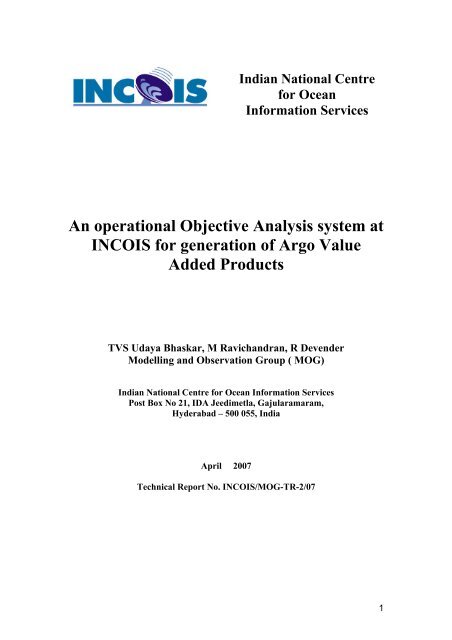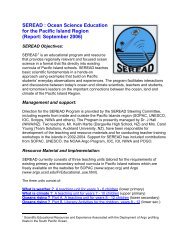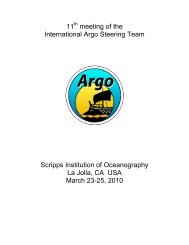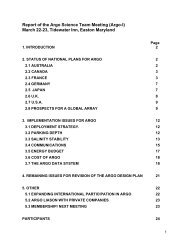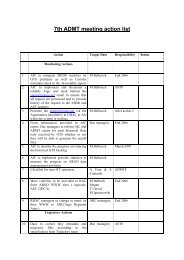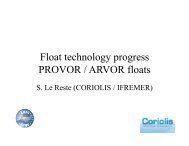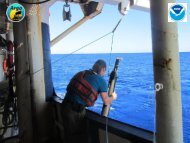An operational Objective Analysis system at INCOIS for ... - Argo
An operational Objective Analysis system at INCOIS for ... - Argo
An operational Objective Analysis system at INCOIS for ... - Argo
You also want an ePaper? Increase the reach of your titles
YUMPU automatically turns print PDFs into web optimized ePapers that Google loves.
Indian N<strong>at</strong>ional Centre<br />
<strong>for</strong> Ocean<br />
In<strong>for</strong>m<strong>at</strong>ion Services<br />
<strong>An</strong> <strong>oper<strong>at</strong>ional</strong> <strong>Objective</strong> <strong>An</strong>alysis <strong>system</strong> <strong>at</strong><br />
<strong>INCOIS</strong> <strong>for</strong> gener<strong>at</strong>ion of <strong>Argo</strong> Value<br />
Added Products<br />
TVS Udaya Bhaskar, M Ravichandran, R Devender<br />
Modelling and Observ<strong>at</strong>ion Group ( MOG)<br />
Indian N<strong>at</strong>ional Centre <strong>for</strong> Ocean In<strong>for</strong>m<strong>at</strong>ion Services<br />
Post Box No 21, IDA Jeedimetla, Gajularamaram,<br />
Hyderabad – 500 055, India<br />
April 2007<br />
Technical Report No. <strong>INCOIS</strong>/MOG-TR-2/07<br />
1
Table of Contents<br />
1. Abstract 4<br />
2. INTRODUCTION 5<br />
2.1 <strong>Objective</strong> <strong>An</strong>alysis definition 5<br />
2.2 <strong>An</strong>alysis equ<strong>at</strong>ion 7<br />
2.3 Importance of background field 8<br />
3. Kessler and McCreary methodology<br />
3.1 D<strong>at</strong>a 9<br />
3.2 Methodology 9<br />
4. General deriv<strong>at</strong>ion of <strong>Objective</strong> <strong>An</strong>alysis equ<strong>at</strong>ion 10<br />
4.1 The deriv<strong>at</strong>ion 10<br />
4.2 Linear Observ<strong>at</strong>ions 13<br />
5 Monthly <strong>Argo</strong> Value added products 15<br />
5.1 Temper<strong>at</strong>ure 15<br />
5.2 Salinity 18<br />
5.3 Geostrophic Currents 21<br />
2
5.4 Mixed Layer Depth, Isothermal Layer Depth 24<br />
5.5 He<strong>at</strong> Content (300 m), D20, D26, Dynamic Height 25<br />
5.6 Sea Surface Height <strong>An</strong>omaly, Wind Speed 27<br />
6. Acknowledgement 28<br />
7. References 29<br />
8. Appendix - 1 30<br />
9. Appendix - 2 31<br />
3
1. Abstract<br />
The <strong>system</strong> of objective analysis used <strong>at</strong> Indian N<strong>at</strong>ional Centre <strong>for</strong> Ocean<br />
In<strong>for</strong>m<strong>at</strong>ion Services is described. It is a integral part of the <strong>Argo</strong> d<strong>at</strong>a processing<br />
<strong>system</strong>, and designed to oper<strong>at</strong>e with minimum of manual intervention. The analysis<br />
method, based mainly on the method of McCreary and Kessler is a method of<br />
estim<strong>at</strong>ing Gaussian weight <strong>for</strong> all the observ<strong>at</strong>ion used <strong>for</strong> estim<strong>at</strong>ing the value <strong>at</strong><br />
grid loc<strong>at</strong>ion. The errors are determined from a comparison of the observ<strong>at</strong>ion with<br />
the estim<strong>at</strong>ed value. The analysis <strong>system</strong> is very flexible, and has been used to analyse<br />
many different types of variables.<br />
4
2. Introduction<br />
A fundamental problem in the geophysical sciences is how to use d<strong>at</strong>a collected <strong>at</strong><br />
finite number of loc<strong>at</strong>ions, and eventually <strong>at</strong> different times, to estim<strong>at</strong>e value <strong>at</strong> any<br />
point of the space or space-time continuum. The ultim<strong>at</strong>e aim of such estim<strong>at</strong>e can be<br />
a simple visualiz<strong>at</strong>ion of the observed field, diagnosis of physical process of the use<br />
of the estim<strong>at</strong>ed field as input <strong>for</strong> numerical models, among many other applic<strong>at</strong>ions.<br />
A wide set of techniques have been developed <strong>for</strong> both diagnostic and prognostic<br />
studies/analyses. Since the development of computers in the last decades made<br />
possible the autom<strong>at</strong>ic implement<strong>at</strong>ion of these techniques, they have been referred to<br />
as sp<strong>at</strong>ial objective analysis. To put it in a nut shell <strong>Objective</strong> <strong>An</strong>alysis (OA) is the<br />
process of trans<strong>for</strong>ming d<strong>at</strong>a from observ<strong>at</strong>ions <strong>at</strong> irregularly spaced points into d<strong>at</strong>a<br />
<strong>at</strong> points of regularly arranged grid.<br />
2.1 <strong>Objective</strong> <strong>An</strong>alysis definition<br />
The graphic (figure 1) depicts the basic problem of OA, namely th<strong>at</strong> we have<br />
irregularly spaced observ<strong>at</strong>ions th<strong>at</strong> must provide values <strong>for</strong> points on a regularly<br />
spaced grid. (Red dots represent observ<strong>at</strong>ions and blue dots are grid points.) OA in<br />
general is the process of interpol<strong>at</strong>ing observed values onto the grid points used by the<br />
model/analysis in order to define the initial conditions of the <strong>at</strong>mosphere/ocean.<br />
5
Fig 1 Irregularly spaced observ<strong>at</strong>ions<br />
Why isn’t this just a simple exercise in m<strong>at</strong>hem<strong>at</strong>ical interpol<strong>at</strong>ion? There are several<br />
answers to this question.<br />
1. We can use our knowledge of oceanic behavior to infer additional in<strong>for</strong>m<strong>at</strong>ion from<br />
the d<strong>at</strong>a available in the area. For example, we can use balance rel<strong>at</strong>ionships such as<br />
geostrophy or mass continuity to introduce dynamical consistency into the analysis. If<br />
we use one type of d<strong>at</strong>a to improve the analysis of another, then the analysis is said to<br />
be multivari<strong>at</strong>e.<br />
2. We can adjust the analysis procedure to filter out scales of motion th<strong>at</strong> can’t be<br />
<strong>for</strong>ecast by the model being used. For example, small mesoscale circul<strong>at</strong>ions<br />
represented in the observ<strong>at</strong>ions may need to be smoothed out in an analysis <strong>for</strong> a<br />
global model.<br />
6
3. We can make use of a first guess field or background field provided by an earlier<br />
<strong>for</strong>ecast from the same model. The blending of the background fields and the<br />
observ<strong>at</strong>ions in the objective analysis process is especially important in d<strong>at</strong>a sparse<br />
areas. It allows us to avoid extrapol<strong>at</strong>ion of observ<strong>at</strong>ion values into regions distant<br />
from the observ<strong>at</strong>ion sites. The background field can also provide detail (such as<br />
frontal loc<strong>at</strong>ions th<strong>at</strong> exist between observ<strong>at</strong>ions).<br />
Using a background field also helps to introduce dynamical consistency between the<br />
analysis and the model. In other words, th<strong>at</strong> part of the analysis th<strong>at</strong> comes from the<br />
background field is already consistent with the physical (dynamic) rel<strong>at</strong>ionships<br />
implied by the equ<strong>at</strong>ions used in the model.<br />
4. We can also make use of our knowledge of the probable errors associ<strong>at</strong>ed with each<br />
observ<strong>at</strong>ion. We can weight the reliability of each type of observ<strong>at</strong>ion based on past<br />
records of accuracy.<br />
2.2 <strong>An</strong>alysis Equ<strong>at</strong>ion<br />
Now we will examine a fundamental OA equ<strong>at</strong>ion in worded <strong>for</strong>m in order to<br />
illustr<strong>at</strong>e the basic principles th<strong>at</strong> contribute to a numerical oceanography analysis.<br />
In simplest terms, the OA equ<strong>at</strong>ion <strong>at</strong>tempts to determine the value of a particular<br />
oceanographic variable <strong>at</strong> a particular grid point (<strong>at</strong> a particular valid time).<br />
In words, the analysis equ<strong>at</strong>ion can be expressed as shown below (figure 2).<br />
7
Fig 2 <strong>Objective</strong> <strong>An</strong>alysis equ<strong>at</strong>ion<br />
2.3 Importance of Background Field<br />
In the simplest kind of OA scheme, the background values would not be used and the<br />
analysis would be based solely on new observ<strong>at</strong>ions. In this case the equ<strong>at</strong>ion would<br />
become:<br />
The observ<strong>at</strong>ions themselves would be interpol<strong>at</strong>ed to the grid point by calcul<strong>at</strong>ing a<br />
weighted average of the d<strong>at</strong>a. (One type of weight, <strong>for</strong> example, is proportional to the<br />
distance of the d<strong>at</strong>a from the grid point. The farther an observ<strong>at</strong>ion is from the grid<br />
point, the less weight it gets.)<br />
8
If a grid point has no nearby observ<strong>at</strong>ions, the simple scheme described here is in<br />
trouble!<br />
3. Kessler and McCreary Methodology<br />
3.1 D<strong>at</strong>a<br />
The d<strong>at</strong>a used in this analysis consisted of all the CTD d<strong>at</strong>a measured by <strong>Argo</strong> flo<strong>at</strong>s<br />
in the Indian Ocean region (30º E – 120º E and 30º S – 30º N). The profiles’ d<strong>at</strong>a were<br />
obtained from the <strong>INCOIS</strong> web site<br />
(http://www.incois.gov.in/Incois/argo/argo_webGIS_intro.jsp#) which are made<br />
available by USGODAE and IFREMER. <strong>Argo</strong> flo<strong>at</strong>s measure T/S from surface to<br />
2000 m depth every 5/10 days. All profiles were subjected to real time quality control<br />
checks like density inversion test, spike test and gradient test (see Wong et al., 2004).<br />
3.2 Methodology<br />
The gridding was carried out in two steps. First the temper<strong>at</strong>ure d<strong>at</strong>a Tn (x n , y n , z n , t n )<br />
from each profile n were linearly interpol<strong>at</strong>ed to standard depths (1 m from surface to<br />
2000 m) there by cre<strong>at</strong>ing a modified d<strong>at</strong>a set T ’ n (x n , y n , z n , t n ). This interpol<strong>at</strong>ion was<br />
done only when two sample in a profile are with in a selected vertical distances which<br />
increased from 5 m in the surface to 100 between 500 – 2000 m. Second, in a separ<strong>at</strong>e<br />
comput<strong>at</strong>ion <strong>at</strong> each Levitus standard depth Z 0 (0, 10, 20, 30, 50, 75, 100, 125, 150,<br />
200, 250, 300, 400, 500, 600, 700, 800, 900, 1000, 1200, 1400, 1600, 1800, 2000 m)<br />
the temper<strong>at</strong>ure T ’ n were mapped from irregular grid loc<strong>at</strong>ions (x n , y n , z n ) to regular<br />
grid (x 0 , y 0 , z 0 ) loc<strong>at</strong>ions with a grid spacing of 1º X 1º . Specifically the value of the<br />
gridded temper<strong>at</strong>ure T ’’ <strong>at</strong> each grid point (x 0 , y 0 , t 0 ) was estim<strong>at</strong>ed by the oper<strong>at</strong>ion<br />
N<br />
p<br />
∑<br />
T ' nWn<br />
n=<br />
1<br />
T ''(<br />
x0 , y 0,<br />
t 0)<br />
=<br />
Np<br />
(1)<br />
Wn<br />
∑<br />
n=<br />
1<br />
9
where N p is the total number of profiles with in the influence region of a particular<br />
grid point. The Guassian weight function W n is given by<br />
This oper<strong>at</strong>ion is similar to a single iter<strong>at</strong>ion of objective mapping as used by Levitus<br />
(1982). Visualising the three dimensional grid (x 0 , y 0 , z 0 ) with d<strong>at</strong>a points T ’ n(x n , y n ,<br />
z n ) sc<strong>at</strong>tered irregularly through it, the mapping oper<strong>at</strong>ion appears as a ellipsoid<br />
moving from grid point to grid point averaging the points th<strong>at</strong> fall with in th<strong>at</strong> ellipse.<br />
Each d<strong>at</strong>a point falls with in summ<strong>at</strong>ion of several grid points, weighted according to<br />
the distance. In the regions of very sparse sampling, a single d<strong>at</strong>a point may be the<br />
only in<strong>for</strong>m<strong>at</strong>ion <strong>for</strong> one or several grid points. If no d<strong>at</strong>a points fell with in the<br />
ellipsoid <strong>at</strong> a grid point, then th<strong>at</strong> was left blank.<br />
4. General Deriv<strong>at</strong>ion of <strong>Objective</strong> <strong>An</strong>alysis Equ<strong>at</strong>ion<br />
In this section, we provide a deriv<strong>at</strong>ion of the Gauss-Markov theorem which is the<br />
found<strong>at</strong>ion <strong>for</strong> the method of <strong>Objective</strong> <strong>An</strong>alysis which is used in Oceanography and<br />
Meteorology <strong>for</strong> the estim<strong>at</strong>ion of fields based upon incomplete and noisy<br />
observ<strong>at</strong>ions.<br />
4.1 The deriv<strong>at</strong>ion<br />
We want to derive an optimal estim<strong>at</strong>e,<br />
, of a field, x, as a linear combin<strong>at</strong>ion of<br />
observ<strong>at</strong>ion d<strong>at</strong>a, ,<br />
10
(1)<br />
Our goal is to derive the <strong>for</strong>m of the m<strong>at</strong>rix, A, so th<strong>at</strong> the expected mean square<br />
difference between the estim<strong>at</strong>ed field and the actual field ( x ) is minimized,<br />
(2)<br />
If we put (1) into (2) and expand, we get<br />
(3)<br />
If we let C x be the autocorrel<strong>at</strong>ion of the field ( E[x x T ] ),<br />
be the autocorrel<strong>at</strong>ion of<br />
the observ<strong>at</strong>ions ( ), and be the cross correl<strong>at</strong>ion between the field and<br />
the observ<strong>at</strong>ions (<br />
), then we can write the above as<br />
(4)<br />
The next step requires the applic<strong>at</strong>ion of the following m<strong>at</strong>rix identity (proved in the<br />
appendix),<br />
(A - B C -1 ) C (A - B C -1 ) T - B C -1 B T = A C A T - B A T - (B A T ) T (5)<br />
using A in (4) <strong>for</strong> A in (5), and <strong>for</strong> B as well as <strong>for</strong> C, we can reduce (x) to<br />
(6)<br />
11
(note we have also used the fact th<strong>at</strong> ).<br />
The m<strong>at</strong>rices , is an autocorrel<strong>at</strong>ion m<strong>at</strong>rix there<strong>for</strong>e both it and are<br />
nonneg<strong>at</strong>ive definite (see appendix), there<strong>for</strong>e<br />
(7)<br />
and<br />
(8)<br />
are both m<strong>at</strong>rices with positive diagonal elements. This means th<strong>at</strong> the diagonal<br />
elements of<br />
are there<strong>for</strong>e minimized when it is true th<strong>at</strong>,<br />
(9)<br />
There<strong>for</strong>e we have,<br />
(10)<br />
This is the estim<strong>at</strong>or th<strong>at</strong> we are seeking.<br />
(11)<br />
Further, we can write down wh<strong>at</strong> the expected error <strong>for</strong> the estim<strong>at</strong>or as,<br />
(12)<br />
Equ<strong>at</strong>ions (11) and (12) constitute the Gauss-Markov estim<strong>at</strong>or <strong>for</strong> the linear<br />
minimum means square estim<strong>at</strong>e of a random variable.<br />
12
4.2 Linear Observ<strong>at</strong>ions<br />
Upon reflection of equ<strong>at</strong>ions (11) and (12) a problem arises: the determin<strong>at</strong>ion of<br />
and<br />
require having the true field values, x, but all one can actually observe are<br />
the measurement d<strong>at</strong>a .<br />
In order to account <strong>for</strong> this important distinction we need to make some assumptions<br />
about how the measurements are rel<strong>at</strong>ed to the actual st<strong>at</strong>e of the <strong>system</strong>. We will<br />
assume th<strong>at</strong> the observ<strong>at</strong>ions are a linear function of the actual st<strong>at</strong>e plus random<br />
noise,<br />
(13)<br />
where H is a known m<strong>at</strong>rix th<strong>at</strong> maps the d<strong>at</strong>a to the observ<strong>at</strong>ions and v is the random<br />
measurement error or noise. We introduce the index s here in order to be explicit th<strong>at</strong><br />
we are indic<strong>at</strong>ing the values <strong>at</strong> some space-time loc<strong>at</strong>ion s, where the observ<strong>at</strong>ions<br />
are, which is not necessarily the loc<strong>at</strong>ion where the estim<strong>at</strong>e<br />
of the field is being<br />
made.<br />
With this, we can write<br />
(14)<br />
Applying (13) to the definition of<br />
, gives<br />
(15)<br />
13
If we suppose th<strong>at</strong> the actual st<strong>at</strong>e and the noise are uncorrel<strong>at</strong>ed, then the terms, C xv<br />
and C sv are each zero.<br />
So now we have<br />
(16)<br />
and,<br />
(17)<br />
If we consider the case where the measurements<br />
are the same quantity as wh<strong>at</strong> we<br />
are estim<strong>at</strong>ing x (i.e. we are using density d<strong>at</strong>a to estim<strong>at</strong>e the density field, as<br />
opposed to using salinity and temper<strong>at</strong>ure to estim<strong>at</strong>e the density field), then H is just<br />
the identity m<strong>at</strong>rix, so our estim<strong>at</strong>or is,<br />
(18)<br />
and,<br />
(19)<br />
If the noise is white noise, then C v is a diagonal m<strong>at</strong>rix and we see th<strong>at</strong> the effect of<br />
not having the true st<strong>at</strong>e correl<strong>at</strong>ions, but estim<strong>at</strong>es of it based upon the observ<strong>at</strong>ions,<br />
is to increase the diagonal elements of the m<strong>at</strong>rix to be inverted by the measurement<br />
noise variance.<br />
14
5. Monthly <strong>Argo</strong> Value Added Products<br />
5.1 Temper<strong>at</strong>ure products<br />
15
5.2 Salinity Plots<br />
18
5.3 Geostrophic Currents<br />
21
5.4 Mixed Layer Depth and Isothermal Layer Depth<br />
24
5.5 He<strong>at</strong> Content (300 m), D20, D26, Dynamic Height<br />
25
5.6 Wind and Sea Surface Height <strong>An</strong>omaly<br />
27
6. Acknowledgements<br />
We express our gr<strong>at</strong>itude to Director, Indian N<strong>at</strong>ional Centre <strong>for</strong> Ocean In<strong>for</strong>m<strong>at</strong>ion<br />
Services (<strong>INCOIS</strong>) <strong>for</strong> his constant encouragement. <strong>Argo</strong> d<strong>at</strong>a were collected and<br />
made freely available by the Intern<strong>at</strong>ional <strong>Argo</strong> Project and the n<strong>at</strong>ional programmes<br />
th<strong>at</strong> contribute to it (http://www.argo.ucsd.edu, http://argo.jcommops.org). The<br />
authors wish to acknowledge use of the Ferret program, a product of NOAA’s Pacific<br />
Marine Environmental Labor<strong>at</strong>ory, <strong>for</strong> analysis and graphics in this paper.<br />
28
7. References<br />
• Bretherton, F.P., R.E. Davis, and C.B. Fandry, 1976; A technique <strong>for</strong><br />
<strong>Objective</strong> <strong>An</strong>alysis and Design of Oceanographic Experiments applied to<br />
MODE-73, Deep Sea Research, V 23, pp. 559-582<br />
• Carter, E.F. and A.R. Robinson, 1987; <strong>An</strong>alysis Models <strong>for</strong> the Estim<strong>at</strong>ion of<br />
Oceanic Fields, Jour. of Atmospheric and Oceanic Technology, V. 4, No. 1,<br />
pp. 49-74<br />
• Gandin, L.S., 1965; <strong>Objective</strong> <strong>An</strong>alysis of Meteorological Fields, Isreal<br />
Program <strong>for</strong> Scientific Transl<strong>at</strong>ions, Jerusaleum, 242 pages<br />
• Liebelt, P.B., 1967; <strong>An</strong> Introduction to Optimal Estim<strong>at</strong>ion, Addison-Wesley,<br />
Reading Mass., 273 pages<br />
• Kessler and McCreary, 1993: The <strong>An</strong>nual Wind-driven Rossby Wave in the<br />
Subthermocline Equ<strong>at</strong>orial Pacific, Journal of Physical Oceanography 23,<br />
1192 -1207.<br />
• Wong, A., R. Keeley, T. Carval and the <strong>Argo</strong> D<strong>at</strong>a Management Team. 2004.<br />
<strong>Argo</strong> quality control manual, ver. 2.0b, Report, 23 pp.<br />
29
8. Appendix 1<br />
The deriv<strong>at</strong>ion of the Gauss-Markov theorem depended upon the m<strong>at</strong>rix identity,<br />
(1)<br />
This identity is not very intuitive and so we will provide the proof here. This proof<br />
depends upon one assumption being true, th<strong>at</strong> C = C T .<br />
Let us define,<br />
(2)<br />
and,<br />
(3)<br />
If we can establish th<strong>at</strong><br />
, then we have our proof.<br />
We start by expanding X,<br />
X<br />
(A - B C -1 ) C (A - B C -1 ) T - B C -1 B T<br />
= (A - B C -1 ) C (A T - C -T B T ) - B C -1 B T (4)<br />
and since we have assumed th<strong>at</strong> C = C T , then C -1 = C -T , so<br />
X = (A - B C -1 ) C (A T - C -1 B T ) - B C -1 B T<br />
= (A C - B ) (A T - C -1 B T ) - B C -1 B T<br />
= ACA T - BA T - AB T + BC -1 B T - BC -1 B T<br />
= (5)<br />
30
9. Appendix 2<br />
In this note we prove th<strong>at</strong> a covariance m<strong>at</strong>rix is non-neg<strong>at</strong>ive definite.<br />
Consider the product, H, th<strong>at</strong> is the product of an arbitrary vector, a, and the<br />
covariance vector, x:<br />
(1)<br />
We can re-arrange the above by moving the constant vector a inside expect<strong>at</strong>ion<br />
oper<strong>at</strong>or so th<strong>at</strong> we have,<br />
(2)<br />
If we define<br />
(3)<br />
31
(which is a random variable because x is), then (2) is<br />
H = E[ Y T Y] (4)<br />
This ``squared'' quantity is clearly never neg<strong>at</strong>ive, so th<strong>at</strong> we can conclude th<strong>at</strong> the<br />
covariance m<strong>at</strong>rix<br />
is non-neg<strong>at</strong>ive definite.<br />
32


